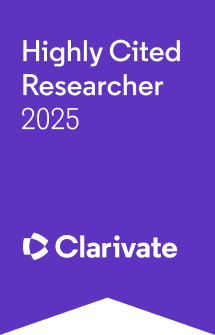
Group Leader
ACADEMIC PROFILES
SOCIAL
REPOSITORIES
CONTACTS
+39 049 827 6260
+39 049 827 6269
BIOGRAPHY
Silvio C. E. Tosatto is currently Full Professor of Bioinformatics and Head of the BioComputing UP lab at the Department of Biomedical Sciences of the University of Padua (Italy). Within ELIXIR, the European infrastructure for blife science data, he is deputy Head of Node of ELIXIR Italy, ExCo of the Data Platform, co-lead of the Cellular & Molecular Research priority area as well as co-lead of the Machine Learning focus group.

ACADEMIC POSITION
Full professor
since (10/2016)
ACADEMIC CAREER & DEGREES
- 2002 – PhD (Dr. rer. nat., Grade: Magna cum laude) in bioinformatics (computer science)
Universität Mannheim – Germany - 1998 – Graduate in Computer Science & Business Administration (Diplom Wirtschaftsinformatiker)
Universität Mannheim – Germany
LANGUAGES
English
Spanish
German
Italian
(Fluent)
(Fluent)
(Native)
(Native)
2025
Journal Articles
Alessio Del Conte; Hamidreza Ghafouri; Damiano Clementel; Ivan Mičetić; Damiano Piovesan; Silvio C. E Tosatto; Alexander Miguel Monzon
DRMAAtic: Dramatically improve your cluster potential Journal Article
In: Bioinformatics Advances, vol. 5, no. 1, 2025, (Cited by: 0; Open Access).
@article{SCOPUS_ID:105008238034,
title = {DRMAAtic: Dramatically improve your cluster potential},
author = {Alessio Del Conte and Hamidreza Ghafouri and Damiano Clementel and Ivan Mičetić and Damiano Piovesan and Silvio C. E Tosatto and Alexander Miguel Monzon},
url = {https://www.scopus.com/record/display.uri?eid=2-s2.0-105008238034&origin=inward},
doi = {10.1093/bioadv/vbaf112},
year = {2025},
date = {2025-01-01},
journal = {Bioinformatics Advances},
volume = {5},
number = {1},
publisher = {Oxford University Press},
abstract = {© 2025 The Author(s).Motivation The accessibility and usability of high-performance computing (HPC) resources remain significant challenges in bioinformatics, particularly for researchers lacking extensive technical expertise. While Distributed Resource Managers (DRMs) optimize resource utilization, the complexities of interfacing with these systems often hinder broader adoption. DRMAAtic addresses these challenges by integrating the Distributed Resource Management Application API (DRMAA) with a user-friendly RESTful interface, simplifying job management across diverse HPC environments. This framework empowers researchers to submit, monitor, and retrieve computational jobs securely and efficiently, without requiring deep knowledge of underlying cluster configurations. Results We present DRMAAtic, a flexible and scalable tool that bridges the gap between web interfaces and HPC infrastructures. Built on the Django REST Framework, DRMAAtic supports seamless job submission and management via HTTP calls. Its modular architecture enables integration with any DRM supporting DRMAA APIs and offers robust features such as role-based access control, throttling mechanisms, and dependency management. Successful applications of DRMAAtic include the RING web server for protein structure analysis, the CAID Prediction Portal for disorder and binding predictions, and the Protein Ensemble Database deposition server. These deployments demonstrate DRMAAtic's potential to enhance computational workflows, improve resource efficiency, and facilitate open science in life sciences.},
note = {Cited by: 0; Open Access},
keywords = {},
pubstate = {published},
tppubtype = {article}
}
Typhaine Paysan-Lafosse; Antonina Andreeva; Matthias Blum; Sara Rocio Chuguransky; Tiago Grego; Beatriz Lazaro Pinto; Gustavo A Salazar; Maxwell L Bileschi; Felipe Llinares-López; Laetitia Meng-Papaxanthos; Lucy J Colwell; Nick V Grishin; R. Dustin Schaeffer; Damiano Clementel; Silvio C. E Tosatto; Erik Sonnhammer; Valerie Wood; Alex Bateman
The Pfam protein families database: Embracing AI/ML Journal Article
In: Nucleic Acids Research, vol. 53, no. D1, pp. D523-D534, 2025, (Cited by: 29; Open Access).
@article{SCOPUS_ID:85214397377,
title = {The Pfam protein families database: Embracing AI/ML},
author = {Typhaine Paysan-Lafosse and Antonina Andreeva and Matthias Blum and Sara Rocio Chuguransky and Tiago Grego and Beatriz Lazaro Pinto and Gustavo A Salazar and Maxwell L Bileschi and Felipe Llinares-López and Laetitia Meng-Papaxanthos and Lucy J Colwell and Nick V Grishin and R. Dustin Schaeffer and Damiano Clementel and Silvio C. E Tosatto and Erik Sonnhammer and Valerie Wood and Alex Bateman},
url = {https://www.scopus.com/record/display.uri?eid=2-s2.0-85214397377&origin=inward},
doi = {10.1093/nar/gkae997},
year = {2025},
date = {2025-01-01},
journal = {Nucleic Acids Research},
volume = {53},
number = {D1},
pages = {D523-D534},
publisher = {Oxford University Press},
abstract = {© 2025 The Author(s) 2024.The Pfam protein families database is a comprehensive collection of protein domains and families used for genome annotation and protein structure and function analysis (https://www.ebi.ac.uk/interpro/). This update describes major developments in Pfam since 2020, including decommissioning the Pfam website and integration with InterPro, harmonization with the ECOD structural classification, and expanded curation of metagenomic, microprotein and repeat-containing families. We highlight how AlphaFold structure predictions are being leveraged to refine domain boundaries and identify new domains. New families discovered through large-scale sequence similarity analysis of AlphaFold models are described. We also detail the development of Pfam-N, which uses deep learning to expand family coverage, achieving an 8.8% increase in UniProtKB coverage compared to standard Pfam. We discuss plans for more frequent Pfam releases integrated with InterPro and the potential for artificial intelligence to further assist curation. Despite recent advances, many protein families remain to be classified, and Pfam continues working toward comprehensive coverage of the protein universe.},
note = {Cited by: 29; Open Access},
keywords = {},
pubstate = {published},
tppubtype = {article}
}
Damiano Clementel; Paula Nazarena Arrías; Soroush Mozaffari; Zarifa Osmanli; Ximena Aixa Castro; RepeatsDB Curators; Carlo Ferrari; Andrey V. Kajava; Silvio C. E. Tosatto; Alexander Miguel Monzon
RepeatsDB in 2025: expanding annotations of structured tandem repeats proteins on AlphaFoldDB Journal Article
In: Nucleic Acids Research, vol. 53, no. D1, pp. D575-D581, 2025, (Cited by: 8; Open Access).
@article{SCOPUS_ID:85211995276,
title = {RepeatsDB in 2025: expanding annotations of structured tandem repeats proteins on AlphaFoldDB},
author = {Damiano Clementel and Paula Nazarena Arrías and Soroush Mozaffari and Zarifa Osmanli and Ximena Aixa Castro and RepeatsDB Curators and Carlo Ferrari and Andrey V. Kajava and Silvio C. E. Tosatto and Alexander Miguel Monzon},
url = {https://www.scopus.com/record/display.uri?eid=2-s2.0-85211995276&origin=inward},
doi = {10.1093/nar/gkae965},
year = {2025},
date = {2025-01-01},
journal = {Nucleic Acids Research},
volume = {53},
number = {D1},
pages = {D575-D581},
publisher = {Oxford University Press},
abstract = {© The Author(s) 2024. Published by Oxford University Press on behalf of Nucleic Acids Research.RepeatsDB (URL: https://repeatsdb.org) stands as a key resource for the classification and annotation of Structured Tandem Repeat Proteins (STRPs), incorporating data from both the Protein Data Bank (PDB) and AlphaFoldDB. This latest release features substantial advancements, including annotations for over 34 000 unique protein sequences from >2000 organisms, representing a fifteenfold increase in coverage. Leveraging state-of-the-art structural alignment tools, RepeatsDB now offers faster and more precise detection of STRPs across both experimental and predicted structures. Key improvements also include a redesigned user interface and enhanced web server, providing an intuitive browsing experience with improved data searchability and accessibility. A new statistics page allows users to explore database metrics based on repeat classifications, while API enhancements support scalability to manage the growing volume of data. These advancements not only refine the understanding of STRPs but also streamline annotation processes, further strengthening RepeatsDB’s role in advancing our understanding of STRP functions.},
note = {Cited by: 8; Open Access},
keywords = {},
pubstate = {published},
tppubtype = {article}
}
Zarifa Osmanli; Elisa Ferrero; Alexander Miguel Monzon; Silvio C. E Tosatto; Damiano Piovesan
GeomeTRe: accurate calculation of geometrical descriptors of tandem repeat proteins Journal Article
In: Bioinformatics, vol. 41, no. 7, 2025, (Cited by: 0; Open Access).
@article{SCOPUS_ID:105012381789,
title = {GeomeTRe: accurate calculation of geometrical descriptors of tandem repeat proteins},
author = {Zarifa Osmanli and Elisa Ferrero and Alexander Miguel Monzon and Silvio C. E Tosatto and Damiano Piovesan},
url = {https://www.scopus.com/record/display.uri?eid=2-s2.0-105012381789&origin=inward},
doi = {10.1093/bioinformatics/btaf395},
year = {2025},
date = {2025-01-01},
journal = {Bioinformatics},
volume = {41},
number = {7},
publisher = {Oxford University Press},
abstract = {© 2025 The Author(s). Motivation Structured tandem repeat proteins (STRPs) are characterized by preserved structural motifs arranged in a modular way. The structural and functional diversity of STRPs makes them particularly important for studying evolution and novel structure-function relationships, and ultimately for designing new synthetic proteins with specific functions. One crucial aspect of their classification is the estimation of geometrical parameters, which can provide better insight into their properties and the relationship between the spatial arrangement of repeated units and protein function. Calculating geometric descriptors for STRPs is challenging because naturally occurring repeats are not "perfect"and often contain insertions and deletions. Existing tools for predicting structural symmetry work well on simple cases but often fail for most natural proteins. Results Here, we present GeomeTRe, an algorithm that calculates geometrical descriptors such as curvature (yaw), twist (roll), and pitch for a protein structure with known repeat unit positions. The algorithm simulates the movement of consecutive units, identifies rotational axes, and calculates the corresponding Tait-Bryan angles. GeomeTRe's parameters can enhance STRP annotation and classification by identifying variations in geometric arrangements among different functional groups. The package is fast and suitable for processing large protein structure datasets when repeat region information (e.g. from RepeatsDB) is available.},
note = {Cited by: 0; Open Access},
keywords = {},
pubstate = {published},
tppubtype = {article}
}
Matthias Blum; Antonina Andreeva; Laise Cavalcanti Florentino; Sara Rocio Chuguransky; Tiago Grego; Emma Hobbs; Beatriz Lazaro Pinto; Ailsa Orr; Typhaine Paysan-Lafosse; Irina Ponamareva; Gustavo A Salazar; Nicola Bordin; Peer Bork; Alan Bridge; Lucy Colwell; Julian Gough; Daniel H Haft; Ivica Letunic; Felipe Llinares-López; Aron Marchler-Bauer; Laetitia Meng-Papaxanthos; Huaiyu Mi; Darren A Natale; Christine A Orengo; Arun P Pandurangan; Damiano Piovesan; Catherine Rivoire; Christian J. A Sigrist; Narmada Thanki; Françoise Thibaud-Nissen; Paul D Thomas; Silvio C. E Tosatto; Cathy H Wu; Alex Bateman
InterPro: The protein sequence classification resource in 2025 Journal Article
In: Nucleic Acids Research, vol. 53, no. D1, pp. D444-D456, 2025, (Cited by: 137; Open Access).
@article{SCOPUS_ID:85214359849,
title = {InterPro: The protein sequence classification resource in 2025},
author = {Matthias Blum and Antonina Andreeva and Laise Cavalcanti Florentino and Sara Rocio Chuguransky and Tiago Grego and Emma Hobbs and Beatriz Lazaro Pinto and Ailsa Orr and Typhaine Paysan-Lafosse and Irina Ponamareva and Gustavo A Salazar and Nicola Bordin and Peer Bork and Alan Bridge and Lucy Colwell and Julian Gough and Daniel H Haft and Ivica Letunic and Felipe Llinares-López and Aron Marchler-Bauer and Laetitia Meng-Papaxanthos and Huaiyu Mi and Darren A Natale and Christine A Orengo and Arun P Pandurangan and Damiano Piovesan and Catherine Rivoire and Christian J. A Sigrist and Narmada Thanki and Françoise Thibaud-Nissen and Paul D Thomas and Silvio C. E Tosatto and Cathy H Wu and Alex Bateman},
url = {https://www.scopus.com/record/display.uri?eid=2-s2.0-85214359849&origin=inward},
doi = {10.1093/nar/gkae1082},
year = {2025},
date = {2025-01-01},
journal = {Nucleic Acids Research},
volume = {53},
number = {D1},
pages = {D444-D456},
publisher = {Oxford University Press},
abstract = {© 2025 The Author(s) 2024.InterPro (https://www.ebi.ac.uk/interpro) is a freely accessible resource for the classification of protein sequences into families. It integrates predictive models, known as signatures, from multiple member databases to classify sequences into families and predict the presence of domains and significant sites. The InterPro database provides annotations for over 200 million sequences, ensuring extensive coverage of UniProtKB, the standard repository of protein sequences, and includes mappings to several other major resources, such as Gene Ontology (GO), Protein Data Bank in Europe (PDBe) and the AlphaFold Protein Structure Database. In this publication, we report on the status of InterPro (version 101.0), detailing new developments in the database, associated web interface and software. Notable updates include the increased integration of structures predicted by AlphaFold and the enhanced description of protein families using artificial intelligence. Over the past two years, more than 5000 new InterPro entries have been created. The InterPro website now offers access to 85 000 protein families and domains from its member databases and serves as a long-Term archive for retired databases. InterPro data, software and tools are freely available.},
note = {Cited by: 137; Open Access},
keywords = {},
pubstate = {published},
tppubtype = {article}
}

